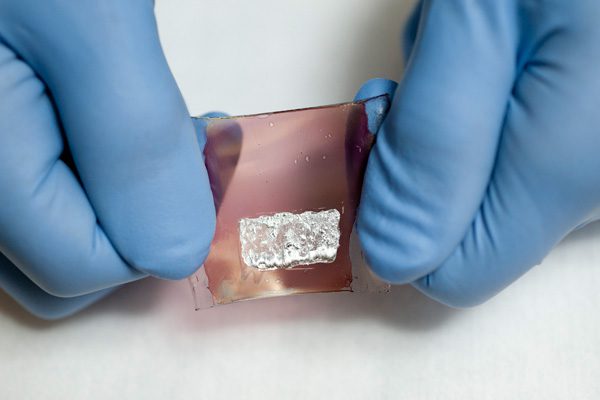Table of Contents
The recent announcement from KAIST researchers signifies a groundbreaking leap in solar cell technology, unveiling the world’s highest-performing stretchable solar cells. These innovative cells possess an exceptional 40% stretch capability during operation, coupled with an impressive conversion efficiency of 19%. Discover how this breakthrough technology of Stretchable Solar Cells could transform wearable devices and flexible electronics.
The key to this breakthrough lies in the researchers’ inventive approach, where they combined a highly stretchable polymer with an electrically conductive polymer through chemical bonding. This synergy resulted in a novel conductive polymer showcasing outstanding electrical properties and mechanical stretchability, allowing the cells to maintain efficiency even under stretching conditions.
Conjugation of Polymers for Stretchable Solar Cells
The core of this breakthrough lies in the inventive combination of a highly stretchable polymer with an electrically conductive polymer through chemical bonding. This unique synergy results in the creation of a new conductive polymer that not only maintains outstanding electrical properties but also exhibits remarkable mechanical stretchability.

Photovoltaic Efficiency Milestone
The researchers proudly proclaim that their creation has achieved the highest reported photovoltaic conversion efficiency of 19% using organic solar cells. This is a noteworthy accomplishment, especially considering the historical performance lag of organic PV cells compared to silicon-based counterparts.
Implications for Wearable Electronics
With a stretch capability of 40%, these solar cells are poised to revolutionize the market for wearable electronic devices. The demand for stretchable cells in this sector is on the rise, and this breakthrough is expected to play a pivotal role in meeting these evolving technological needs.
Published in Joule: Rigid and Soft Block-Copolymerized Conjugated Polymers
The technology’s publication in Joule, titled “Rigid and Soft Block-Copolymerized Conjugated Polymers Enable High-Performance Intrinsically-Stretchable Organic Solar Cells,” sheds light on the methodology. The research utilizes conjugated polymer donors with electroactive rigid and soft blocks to achieve enhanced electrical properties and mechanical stretchability.
Enhanced Properties through Polymer Synthesis
The synthesis of block-copolymerized polymer donors (D180.8-s-PEHDT0.2) using rigid D18 and soft PEHDT blocks contributes to the superior electrical properties and mechanical stretchability of the resulting D180.8-s-PEHDT0.2-organic solar cells (OSCs). This advancement successfully overcomes the traditional power conversion efficiency-stretchability trade-off.
Key Features:
| Features | Description |
|---|---|
| High Efficiency | The organic PV cells exhibit an impressive efficiency of 19%, making them commercially viable for a wide range of applications. This achievement is particularly notable considering the historical performance lag of organic PV cells compared to silicon-based counterparts. |
| Stretchability | These cells boast a remarkable stretchability of up to 40% without compromising performance, distinguishing them from conventional rigid solar panels. This unique characteristic opens up exciting possibilities for seamless integration into flexible devices, curved surfaces, and textiles. |
| Potential Applications | The breakthrough ushers in a new era of possibilities, envisioning applications such as self-charging smartwatches, tents capable of generating their own power, and solar-powered clothing. The stretchable organic PV cells hold the potential to revolutionize various industries, enhancing daily life. |
Leadership and Departmental Involvement
Led by Prof. Bumjoon Kim from KAIST’s Department of Chemical and Biomolecular Engineering, the research team’s leadership underscores the significance of this achievement. The collaboration within the department has played a crucial role in pushing the boundaries of stretchable solar cell technology.

Broader Significance: Beyond Solar Cells
Prof. Kim’s commentary emphasizes the dual achievement of developing the world’s best-performing stretchable organic solar cell and a novel polymer applicable to various electronic devices requiring malleability and elasticity. This broader impact positions the research as a catalyst for the advancement of flexible and adaptable materials across diverse electronic applications.
Related Posts





















Leave feedback about this